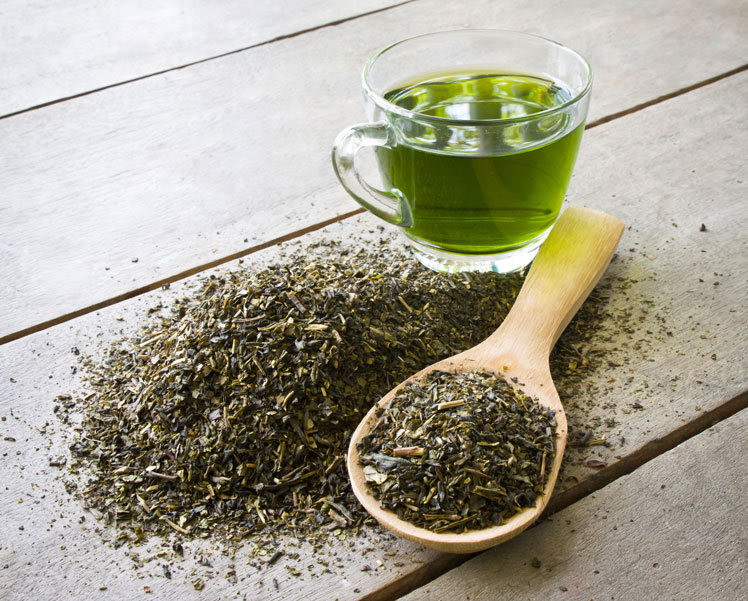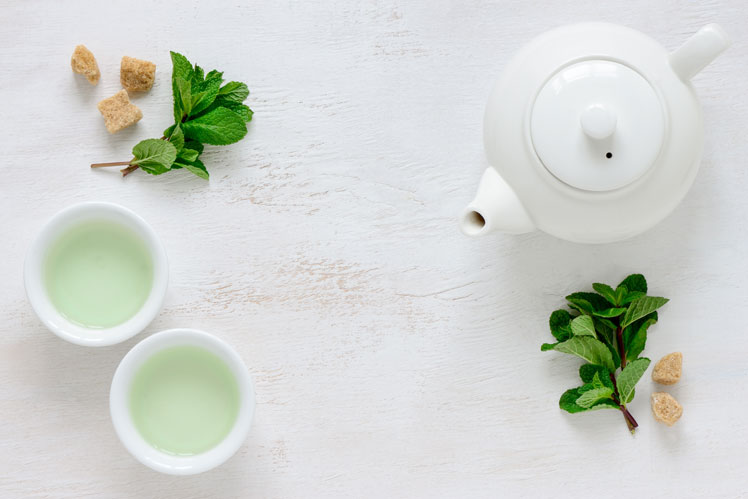
Background photo created by zirconicusso – www.freepik.com
Green tea is tea that has undergone minimal fermentation (oxidation). The main task in the manufacture of green tea is to preserve its biologically active natural substances contained in the tea leaf. That is why the process of making this type of tea is not “aggressive” and is subordinated to the goal of preserving useful substances in the tea leaf.
Both green and black tea are obtained from the leaves of the same tea plant, but in different ways. Green tea is often pre-fixed with steam at a temperature of 170–180 °C. Oxidation of tea is either not carried out at all, or lasts no more than two days, after which it is usually stopped by heating (traditionally in pots, as is customary in China, or under steam, as is customary in Japan). Tea is oxidized by 3-12%.
Ready dried green tea should be green, darkening the tea leaves to brown, dark gray or brown is a sign of poor quality tea.
Numerous East Asian varieties of green tea have noticeable differences due to the conditions of cultivation, collection and processing of tea leaves. Green tea comes from China and is traditionally popular in Asia (Japan, Korea, the Middle East). In more western countries where black tea traditionally predominates, the rise in popularity of green tea came in the late 20th century.
The main world producer of green tea is China, providing about 80% of the world green tea market. Every year there is a significant increase in green tea imports in the US and UK.
Green tea has long been known as a medicinal drink. It is used to normalize blood pressure, strengthen the walls of blood vessels and capillaries. Green tea promotes weight loss, improves digestion of food, and significantly reduces the risk of caries.
Green tea contains a large amount of caffeine and can become bitter when steeped for a long time. Properly brewed green tea contains a unique combination of vitamins, trace elements and other nutrients (such as plant proteins). Let's talk about how to make green tea the right way.


How to brew green tea
The preparation of a tea drink is called brewing. As a rule of thumb, there should be 100 grams per 2 ml of tea water, or about one teaspoon of green tea per 150 ml of water. High-quality teas such as Gyokuro use a larger amount of tea leaf, which can be brewed several times in a short amount of time.
Brewing time and water temperature vary for different varieties of green tea.
-
The highest brewing temperature is 81–87 °C, and the longest brewing time is two to three minutes.
- The lowest brewing temperature is 61–69 °C and the shortest time is about 30 seconds.
Generally, lower quality green tea brews longer and at a higher temperature, while higher quality green tea brews faster and at a lower temperature.
If green tea is brewed in too hot water or for too long, it will be bitter, astringent, regardless of the quality of the variety.
High quality green tea can and usually is brewed several times – 2 or 3 brews.
The brewing technique plays a very important role in keeping the tea from getting overcooked. Preheat the tea pot or teapot to prevent the tea from cooling down immediately. It is customary to add hot water to the tea leaves left in the cup or teapot as the tea is drunk, until the taste is gone.

The effect of green tea on health
Green tea contains polyphenols, specifically catechins, the most common of which is epigallocatechin gallate. Green tea also contains carotenoids, tocopherols, ascorbic acid (vitamin C), minerals such as chromium, manganese, selenium and zinc, and some phytochemicals. It is a stronger antioxidant than black tea.
Experiments, observations and studies show that green tea can reduce the risk of cardiovascular disease, dental caries, kidney stones and cancer.
Over the past few decades, green tea has been subjected to many scientific and medical studies to determine the extent of its health benefits. An official report published by the American Heart Association says that over a 5-year study of 1900 patients with a history of acute myocardial infarction, it was found that the likelihood of dying from a second heart attack was reduced by 44% when drinking more than two cups of tea per day. It has also been observed that regular green tea drinkers have a lower chance of developing heart disease and developing certain types of cancer, but green tea is not recommended for breast cancer prevention.
Green tea consumption has been associated with a reduced risk of heart disease in epidemiological studies. Animal studies have shown that it can lower cholesterol levels. However, several brief human studies have found that tea consumption does not lower cholesterol levels in humans. In 2003, a randomized clinical trial showed that green tea extract supplemented with theaflavin from black tea resulted in lower cholesterol levels.
Studies conducted at the University of Birmingham have shown that the average level of fat oxidation is 17% higher after taking green tea than after taking a placebo. Ingestion of green tea extract may not only increase fat oxidation during moderate-intensity exercise, but also improve insulin sensitivity and glucose tolerance in healthy young men.
Research conducted at Queen Margaret University in Edinburgh, Scotland looked at the effects of short-term consumption of green tea by a group of students aged 19-37. Participants were offered a diet and 4 cups of green tea per day for 14 days. The results showed that such consumption of green tea reduced systolic and diastolic blood pressure, total cholesterol, fat and body weight. These results suggest a role for green tea in reducing the potential for cardiovascular disease risk factors. This study was mainly aimed at the problem of overweight population and reducing the high risk of cardiovascular disease.
In the summer of 2005, the US Food and Drug Administration (FDA) stated that green tea or its extracts have no scientific evidence to reduce the risk of stomach disease, respiratory disease, colon disease, pancreatic disease, and the risk of the formation of cancerous tumors.
In a study conducted at the Israel Institute of Technology, it was shown that the main antioxidant in green tea, polyphenol EGCG, fights Parkinson's disease and Alzheimer's disease in mice, helps protect brain cells. The results of the study, led by Dr. Sylvia Mundell, were presented at the 4th International Science and Technology Symposium on Tea and Human Health in Washington DC in 2007.
A study conducted at the National Institute of Chemistry in Ljubljana (Slovenia) showed that the antimicrobial activity of green tea extract is associated with the suppression of bacterial DNA gyrases.
In a 2004-2005 study of 2018 Chinese women who consumed mushrooms and green tea, their risk of developing breast cancer was 90% less than normal.
A recent rat study at the University of Hong Kong, published in the Journal of Agricultural and Food Chemistry, found that green tea catechins were delivered to the lens, retina, and other parts of the eye after consumption. Absorbed catechins reduce oxidative stress in the eyes for up to 20 hours. It is suggested that green tea may be effective in preventing glaucoma and other eye conditions.
Consuming green tea on an empty stomach lowers blood sugar levels.
Note
The American College of Gastroenterology guidelines state that drinking more than three 240 ml cups of green tea per day can be harmful to health, in particular, in some people it can have an adverse effect on the liver and provoke diseases of this organ. The daily norm should not exceed 500 mg of catechins. It is also noted that it is dangerous to take nutritional supplements containing green tea extract, advertised, in particular, as a means of losing weight. Government regulation of nutritional supplements, according to the authors of the mentioned guide, is not enough, because one tablet often contains more than 700 mg of catechins.
We also recommend:
◆Why tea should be consumed daily?
◆Classification of tea according to its various characteristics
◆What determines the color of tea? Four types of tea and their differences










